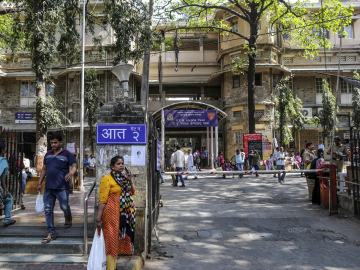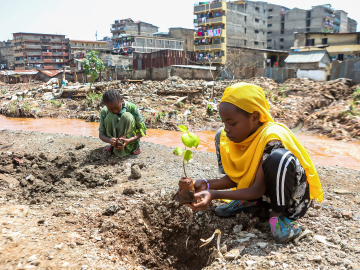Not the Starbucks of Global Health: Vital Strategies Builds From Within
José Luis Castro has a vision of what Vital Strategies should not be: the Starbucks of global health. The nonprofit will not be building bricks and mortar locations across the globe—though its 407 staff members are intent on improving health in 60 countries worldwide. With a focus on noncommunicable diseases, Vital Strategies works closely with health systems to strengthen them from within, says Castro, the organization’s president and CEO. Rather than creating parallel systems of experts and services, Vital Strategies embeds team members in health ministries and health departments for specific projects and sharing knowledge and building skills of local experts. “When our project finishes, there are a number of trained staff that are already in that institution that remain there and continue that work,” Castro says.
As part of Global Health NOW’s occasional Q&A series with global health leaders, Castro talks about sustainability, data, the special challenge of fighting NCDs and why the 2014 high-level meeting on NCDs flopped.
Why Vital Strategies? National health systems exist, and national governments are already there. There’s WHO… How do you explain the need for Vital Strategies?
People are dying. And they’re dying in the millions.
Millions of these deaths are unnecessary. They are unnecessary because both the government and the public health system … could have prevented them and prevented them in a significant way by protecting the population from harms of smoke or from pollution, even from infectious diseases [and] noncommunicable diseases.
In a robust public health system, we can identify the causes and identify also what are the policies and the interventions that need to be put in place in those countries, in those municipalities, to prevent those deaths. I think that’s why what we in Vital Strategies do is help strengthen those institutions.
How explicit do you make the goal of sustainability so that when Vital Strategies leaves, everything continues and it doesn’t just stop as soon as you walk out the door?
For one thing... we don’t build bricks and mortar. We don’t build the Vital Strategies structure like Starbucks that goes and builds coffee shops. We work within the public health institutions … and help strengthen the personnel there. So, when our project finishes, there are a number of trained staff that are already in that institution that remain there and continue that work. And I think that’s the model that ensures that the country has the ability to sustain an initiative.
Of course, they need the financial resources too sometimes. By the time we finish an intervention, the country doesn’t have all the financial resources, but at least it has the know-how, and it has the experts inside, and those who can advocate to get the resources that it needs to keep the intervention going.
I want to ask you about the importance of data to what you’re trying to achieve at Vital Strategies. How do you emphasize that in Vital Strategies’ work?
The work that we do in data is crucial in helping countries develop the systems to measure and understand what are the causes of mortality in the country so then they have information, intelligence on what are some of the leading diseases [and] can address them.
Imagine there’s some countries where there is no information and no one has kept record or some countries that have lots of information, piles of records, but no one has sat down to analyze. And I think as, one minister told a colleague of mine, they’re data rich but information poor. Helping the countries build the systems to obtain and to analyze the data and also to understand how to apply that data or use that data for policy is a crucial part of the Vital Strategies work. We’re working in 20 countries helping these countries develop their civil registration and vital statistics systems, both birth certificates and death certificates. Imagine that you’re someone born in a country [and] never had a birth certificate. You don’t have a nationality if you don’t have a birth certificate. There are millions of people like that around the world, and they happen to be born in a country or a city that doesn’t have the capacity or capability to do that.
You’re talking about literally building a civilian registration and vital statistics system for a country?
In some countries that has been the case.
Is this a tough sell to countries, to persuade them to invest in these systems? They can look around and say, we should be using this money for bednets or contraception or whatever.
Whenever I go around the world, the one thing that everyone comes to ask me about is our CRVS work—country after country wherever I talk. And it seems like in a way it is in that it’s abstract or too technical, but I think when you bring it down to the level of birth and death and the understanding of it, these are two basic documents like a family needs.
What are a couple of your most valuable lessons learned from projects that didn’t go well?
I cannot stress enough the importance of building strong partnerships. I think whenever we start a project, those partnerships, you have to be solid in the partners that you know are reliable, and are going to participate fully and deliver.
Number 2 is that the people you assign to carry it out. You can have a top expert who works well in London or works well in New York. If that person goes to Kuala Lumpur or goes to Manila, [he or she] may not be able to sell the work or get the expertise.
What projects do you have underway that you’re most excited about?
One that we’re excited, it’s like a flagship project of our public health division is the Healthy Cities partnership, which we launched last year with support from Bloomberg Philanthropies, in 54 cities around the world. They select from many of the 10 best buys for cities to implement those. And now we are the stage [of] translating those proposals that they made to us … to action. [It] highlights the importance of the issues of noncommunicable disease problem, and hopefully this will now bring it to a level of visibility and importance and it keeps going.
Is this one mostly communication programs? Is that what you’re saying or...?
You know, it depends. Some are road safety programs helping with signage and collection of data, and some are communications … and others to change some regulations or even the establishment of smokefree zones sort of thing.
What are your thoughts on handling the special challenge of NCDs. People seem to just accept them: “Oh, people are going to have heart attacks. That’s just part of life.”
It is a challenge, but... the magnitude of NCDs is so huge. I mean, close to 40 million people every year are dying of NCDs. And clearly, I don’t go to the doctor and say, “I have an NCD.” We have a challenge with that name, but look around when you walk down the street … how many persons have some of these conditions.
I think our messaging has to be clear to focus people on what the tragedy is. That that young man that is obese now, in a few years will develop diabetes, and if not treated well, [he] will have a … limb amputated. And is that the population that you want to see in a city? I mean for any leader or any mayor of any city—is that how you want to see their cities evolving, the population? Or suffering from chronic respiratory diseases because of the poor quality of the air?
You mentioned earlier the high-level meeting NCDs meeting coming up in September. What results do you hope will come of that meeting?
As you know, this would be the third high-level meeting on noncommunicable diseases. It is a very important meeting as the countries are going to come to report on progress that has been made on what had been agreed on the previous meetings. As you know, the meeting in 2014, I think it was a flop in many ways, because … there was no single head of state in attendance. So, it’s important that in the next high-level meeting that it has the participation of heads of the state and heads of governments to demonstrate the political commitment to NCDs.
What is also important is this should not be a meeting for more declarations. We really know the burden of disease, we really know what are the causes, we already know what has to be done to address these issues. This is a time when countries much come prepared to make commitments and say, “I want to address this issue” ... or “we’re working to review the noncommunicable diseases” according to the goals that they have. What I fear is whenever there are these high-level meetings, some countries come and make declarations and commitments that they know very well are not going to be carried out.
Is there any way to prevent that?
I think so. I think what is different in this high-level meeting is the involvement and participation of the civil society that was not in the first two meetings. A strong civil society … helps in keeping the governments accountable. We need accountability both for the commitment to the global goals but also to what has been committed by the governments to do internally.
Here’s another question about leadership, but about your leadership of Vital Strategies. You’ve grown tremendously—doubled in size in the last year or so. You’ve got people working in many different countries. How do you lead such a diverse organization that’s very global?
I think that it’s all about people. We are very selective in the type of people that we bring into the organization and spend significant amount of time in the selection process, but we also have a very high caliber management team and country leads that help us do that work.
I think that as we grow, one thing that I have continued to stress to my colleagues and management team is the importance of ensuring that we continue to provide the value that we add as an organization to this work: … the quality, the speed, the agility, the sense of urgency that my team has. Because, as I’ve said, people are dying, and the only way to address that, you really have to have a sense of urgency.
The third thing is also the organization has to be accountable, I think is important too, to be accountable to yourself, to the public, and to your donors on the work that you’re doing that you deliver.
How do you as a leader make sure that the partnership actually happens on the ground and that there is that level of respect when you’re working with your partners in other countries?
I think that the most important thing in any partnership is the amount of communication and trust that you develop both as an organization but also with individuals that are engaged on the day-to-day activities. It is important that the partners feel sufficient trust that would allow us to embed a staff inside a government agency without thinking we’re putting a spy here or thinking that they’re trying to, you know, just creating problems.
We have 130 staff embedded around the world. That is 25% of our working force, and when we were talking earlier about sustainability, this is how we leave it. We’re … strengthening from within the system.
Ed. Note: Michael R. Bloomberg is a benefactor of the Johns Hopkins Bloomberg School of Public Health, which publishes Global Health NOW.
Join the tens of thousands of subscribers in more than 100 countries who rely on Global Health NOW summaries and exclusive articles for the latest public health news. Sign up for our free weekday enewsletter, and please share the link with friends and colleagues: http://www.globalhealthnow.org/subscribe.html
José Luis Castro, president and CEO of Vital Strategies. (Photo courtesy)





